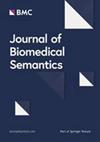平等与德语so…以及度与属性之间的关系
IF 1.6
3区 工程技术
Q3 MATHEMATICAL & COMPUTATIONAL BIOLOGY
引用次数: 2
摘要
本文对德语中两种程度等价和性质等价的构式在个体或事件领域进行了结构透明、统一的语义分析。与英语和许多其他欧洲语言不同(Haspelmath & Buchholz 1998, Rett 2013),德语中的两种等式类型都以参数标记so为特征,表明了统一的分析。我们表明,德语程度和性质等号的平行形式表达伴随着平行的句法分布(在谓语、定语和状语位置上)和相同的语义属性:两种等号类型都允许范围歧义,显示出上下文外的负面岛屿效应,并允许补语从句中的消极极性项本文章由计算机程序翻译,如有差异,请以英文原文为准。
Comparisons of Equality With German so...wie, and the Relationship Between Degrees and Properties
We present a compositionally transparent, unified semantic analysis of two kinds of so…wie-equative constructions in German, namely degree equatives and property equatives in the domain of individuals or events. Unlike in English and many other European languages (Haspelmath & Buchholz 1998, Rett 2013), both equative types in German feature the parameter marker so, suggesting a unified analysis. We show that the parallel formal expression of German degree and property equatives is accompanied by a parallel syntactic distribution (in predicative, attributive, and adverbial position), and by identical semantic properties: Both equative types allow for scope ambiguities, show negative island effects out of context, and license the negative polarity item überhaupt ‘at all’ in the complement clause. As the same properties are also shared by German comparatives, we adopt the influential quantificational analysis of comparatives in von Stechow (1984ab), Heim (1985, 2001, 2007), and Beck (2011), and treat both German equative types in a uniform manner as expressing universal quantification over sets of degrees or over sets of properties (of individuals or events). Conceptually, the uniform marking of degree-related and property-related meanings is expected given that the abstract semantic category degree (type $d$) can be reconstructed in terms of equivalence classes, i.e., ontologically simpler sets of individuals (type $\langle e,t\rangle $) or events (type $\langle v,t\rangle $). These are found in any language, showing that whether or not a language makes explicit reference to degrees (by means of gradable adjectives, degree question words, degree-only equatives) does not follow on general conceptual or semantic grounds, but is determined by the grammar of that language.
求助全文
通过发布文献求助,成功后即可免费获取论文全文。
去求助
来源期刊

Journal of Biomedical Semantics
MATHEMATICAL & COMPUTATIONAL BIOLOGY-
CiteScore
4.20
自引率
5.30%
发文量
28
审稿时长
30 weeks
期刊介绍:
Journal of Biomedical Semantics addresses issues of semantic enrichment and semantic processing in the biomedical domain. The scope of the journal covers two main areas:
Infrastructure for biomedical semantics: focusing on semantic resources and repositories, meta-data management and resource description, knowledge representation and semantic frameworks, the Biomedical Semantic Web, and semantic interoperability.
Semantic mining, annotation, and analysis: focusing on approaches and applications of semantic resources; and tools for investigation, reasoning, prediction, and discoveries in biomedicine.
 求助内容:
求助内容: 应助结果提醒方式:
应助结果提醒方式:


